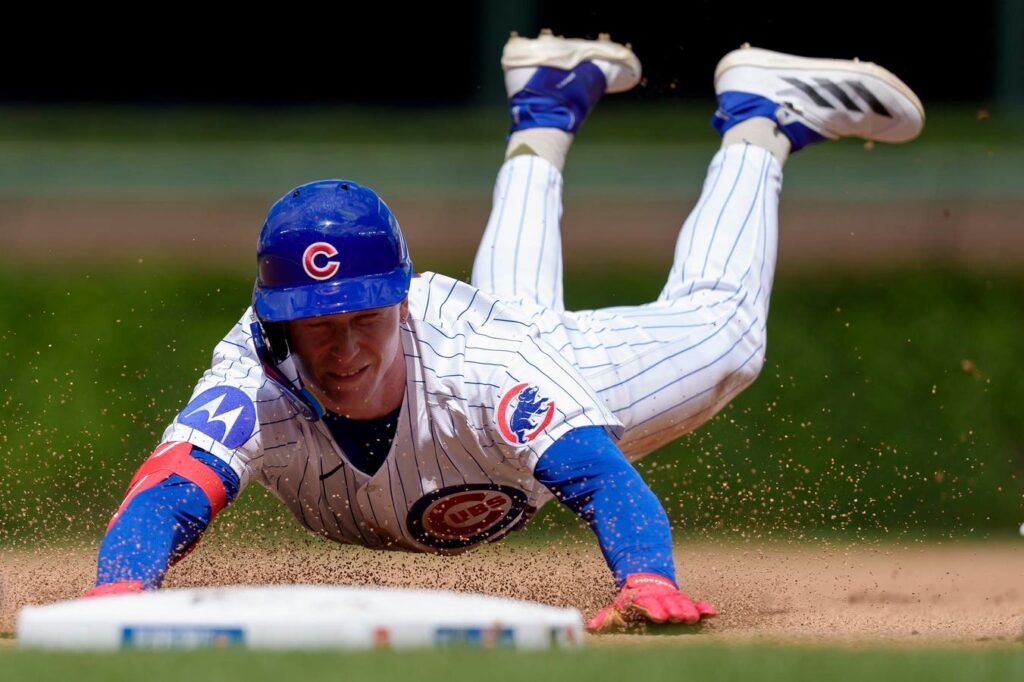CHICAGO, ILLINOIS – MAY 17: Pete Crow-Armstrong #4 of the Chicago Cubs dives head first into third … More
Getty ImagesJed Hoyer’s intention is clear. He plans to identify the best available pitchers — starters and relievers — and move to acquire a few of them before the trade deadline.
It’s a reasonable and perhaps unavoidable plan given how well the Cubs are positioned for the postseason after the run of frustration and irrelevance that followed the tingly feelings that came with the 2016 championship. But history says Hoyer and his general manager, Carter Hawkins, need to proceed cautiously as July 31 approaches.
Mid-season trades work out in favor of the team shedding established talent far more often than for the teams adding those veterans for the stretch run of the season. Yet the short-term rewards — not to mention the adrenaline rushes — are always tempting. This can be especially true for an executive nearing the end of his contract, such as Hoyer, the Cubs’ president of baseball operations.
Hoyer was Theo Epstein’s assistant in ’16, when the Cubs made a trade with the Yankees for Aroldis Chapman. They may not have rolled through the Giants, Dodgers and Indians without having imported Chapman to supplant Hector Rondon as closer but the cost to get Chapman was then 19-year-old infielder Gleyber Torres, pitcher Adam Warren and two other prospects.
Since Epstein reluctantly parted with Torres — who at the time was blocked by Javier Baez and Addison Russell — he has accrued 17.5 career WAR with the Yankees and Tigers. He’s currently hitting second for a Detroit team that is among the American League’s best teams. The Cubs opted not to re-sign Chapman, who has since passed through the Yankees (returning after the trade), Royals Rangers and Pirates and is now closing games for Boston.
But Chapman did all he needed to do in Chicago when he worked a scoreless ninth inning in Game Seven of the World Series, famously won in 10 innings (after a dramatic rain delay). If the Cubs can get back to the Series this October, few will quibble about however high of a price Hoyer pays to get there.
But there’s always a risk in trading prospects. Just ask the Mets.
They were 55-47 in the summer of 2021, leading the NL East by four games, when the Cubs made free agents-to-be Anthony Rizzo, Kris Bryant and Baez available after not signing them to contract extensions. The Mets added Baez to play alongside Francisco Lindor, giving up then 19-year-old center fielder Pete Crow-Armstrong,
In only his third big-league season — the first in which he was on the Opening Day roster — Crow-Armstrong has already accumulating 6.6 WAR over 215 games. The two-way talent is hitting .308 with 21 home runs and 24 stolen bases, along with elite defense. As for Baez and the ’21 Mets, they went 22-38 after the trade and missed the postseason.
However, the Cubs have more often made aggressive trades since winning the World Series. These trades have rarely yields the critical wins to justify their high costs.
When Epstein wanted a proven starter in 2017, he sent then 21-year pitcher Dylan Cease and power-hitting outfield prospect Eloy Jimenez to the White Sox for Jose Quintana. The Cubs, who were 43-45 at the time of the deal, rallied to win the NL Central with 92 wins but reached the end of their promising, three-season postseason run in the National League Championship Series.
Quintana was 33-23 in his four seasons based at Wrigley Field. That was far better than the work of left-handed reliever Justin Wilson, who cost Epstein then-23-year-old third baseman Jeimer Candelario and 18-year-old infielder Isaac Paredes in a trade with Detroit.
A year later, Epstein added lefty Cole Hamels and potential closer Brandon Kintzler in deadline trades. Then he reached for Nick Castellanos, catcher Martin Maldonado and reliever Brad Wieck in ’19. These trades weren’t nearly as costly as the Quintana and Wilson trades but failed to add much when it mattered.
Baseball’s current landscape seems set for the Cubs to be one of the busiest pursuers of roster upgrades. The lineup is humming behind Kyle Tucker, Seiya Suzuki and Crow-Armstrong, with run production at 5.4 runs per game, second in the majors. The rotation has been thin since early injuries to Justin Steele and Javier Assad, and the largely untested Daniel Palencia is filling the closer’s role.
Meanwhile the Cubs may have the deepest inventory of minor-league talent among buyers.
Hoyer should be able to swing major deals if he willing to sacrifice advanced prospects like catcher-DH Moises Ballesteros, first baseman Jonathan Long, infielder-outfielder James Triantos and outfielders Owen Caissie and Kevin Alcantara, who continue sharpening their skills in Triple-A. But the biggest risk may come in trading teenagers who are on the fringe of the radar.
Think about the 2016 White Sox. They were trying to win behind Jose Abreu, Todd Frazier, Chris Sale and Quintana but felt they were a starting pitcher short. The front office duo of Rick Hahn and Ken Williams traded a 17-year-old shortstop for James Shields. That shortstop, Fernando Tatis Jr., reached the big leagues only two years later and now holds a $340 million contract with the Padres.
There’s a likelihood that opposing front offices will ask about a trio of Dominican middle infielders the Cubs recently signed. Hoyer invested a combined $4.9 million in Wilfri De La Cruz, Juan Cabada and Juan Tomas, and all of them excite scouts.
One scout sees Tomas as being similar to the Reds’ Elly De La Cruz, presenting 30-homer, 30-stolen base potential. He stands 6-2, switch hits and flashes a big arm. Yet MLB Pipeline ranks him as only the Cubs’ 11th best prospect, which could make him seem like a small part of a big trade.
These are intriguing times for contenders. But it’s the teams trading veterans who are likely to be the long-term winners.
Read the full article here


